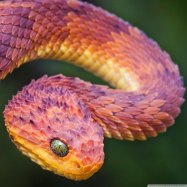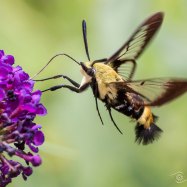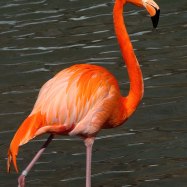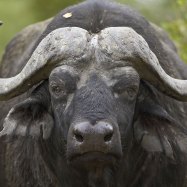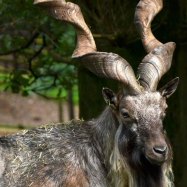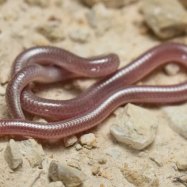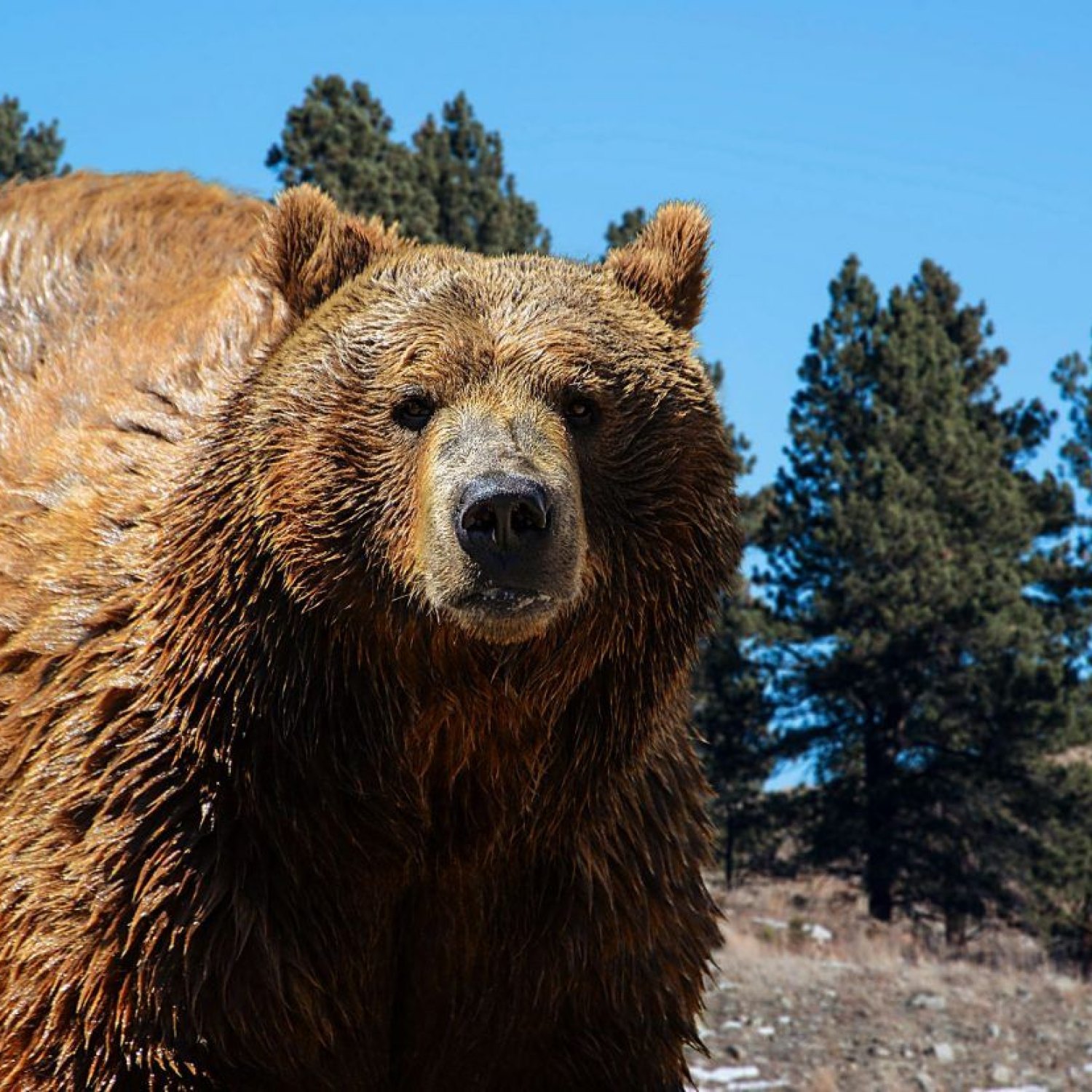
Grizzly Bear
6 to 8 feet
Did you know that the Grizzly Bear, found in the Rocky Mountains, Alaska, and western Canada, belongs to the Ursidae family and can grow up to 6 to 8 feet? With a large and muscular body, they are known for their strength and hunting skills. #GrizzlyBear #Ursidae #Wildlife
Animal Details Summary:
Common Name: Grizzly Bear
Kingdom: Animalia
Habitat: Mountainous and forested regions
Grizzly Bears: The Fierce and Fascinating Giants of North America
North America is home to a diverse range of wildlife, from the elusive cougars to the iconic bald eagles. However, one animal stands out in this vast and varied ecosystem- the grizzly bear. Known for their impressive size, fierce nature, and stunning appearance, grizzly bears have captured the imagination of people for centuries.But what makes these massive creatures so special and unique? Let's delve deep into their world and unravel the fascinating facts about grizzly bears Grizzly Bear.
The Basics: Ursus arctos horribilis
Grizzly bears, also known as North American brown bears, are scientifically called Ursus arctos horribilis. They belong to the kingdom Animalia, the phylum Chordata, the class Mammalia, and the order Carnivora. Grizzly bears are also part of the family Ursidae, which includes other bears like polar bears, black bears, and pandas.Where Do They Live?
Grizzly bears are found in the mountainous and forested regions of North America, specifically in the United States and Canada. These powerful animals can be spotted in the Rocky Mountains, Alaska, and western Canada, making them a treasured part of these landscapes.Feeding Habits
Grizzly bears are impressively adaptable animals, as they have a diverse diet. They are primarily omnivorous, meaning they feed on both plants and animals. Their diet mainly consists of plant matter such as roots, berries, and nuts, but they are also skilled hunters and will prey on a wide range of animals, from small rodents to bigger mammals like moose.Their Habitat: Mountains and Forests
As mentioned earlier, grizzly bears thrive in mountainous and forested regions Giant Armadillo. These habitats provide ample vegetation and prey for the bears to survive. Grizzly bears also have a keen sense of smell, excellent climbing abilities, and can swim, making these environments their perfect home.The Mighty Grizzly Bear
When you think of grizzly bears, one of the first things that come to mind is their impressive size and strength. These animals are incredibly muscular and can grow as tall as 10 feet when standing on their hind legs, with females being slightly smaller than males.On average, grizzly bears can be 6 to 8 feet long and weigh between 800 to 1500 pounds. These measurements make them one of the largest species of bears in the world, with only the polar bear and the Kodiak bear being slightly bigger.
Brown is the Color
Grizzly bears have a distinctive brown fur coat, ranging from light tan to dark brown, giving them their common name. But did you know that the color of their fur can also be influenced by their environment? Bears living in colder regions tend to have lighter-colored fur, while those in warmer climates have darker fur to absorb heat.Their fur also has a thick and dense undercoat, helping them endure the harsh winters in their natural habitat. But don't be fooled by their cozy appearance; their fur is also an essential defense mechanism against predators and harsh weather conditions.
The Grizzlies are Here to Stay
Grizzly bears have been an integral part of the North American ecosystem for thousands of years, and they continue to play an essential role in maintaining a healthy balance. However, in the 19th and 20th centuries, their population faced a severe decline due to hunting, habitat destruction, and human conflicts.But thanks to conservation efforts and strict regulations, their population has been on the rise. It is estimated that there are about 55,000 grizzly bears in North America today. Nevertheless, due to their slow reproductive rate and the ongoing threats of climate change and habitat loss, grizzly bears remain an endangered species.
Intricate Social Structures
Grizzly bears may seem solitary, but they have intricate social structures within their communities. While males and females mostly live solitary lives, they do come together for breeding purposes. And when it comes to raising their young, female bears are fiercely protective and nurturing.Female grizzly bears reproduce every 3-4 years and give birth to 1-4 cubs, usually during the winter months. The mothers raise their cubs for about 2-3 years, teaching them how to survive and hunt in the wild before setting them off on their own.
One fascinating fact about grizzly bears is that their social hierarchy is determined by their size and strength. The largest and strongest bears have the highest rank and dominate over the others.
Exploring with NLP
The complexity and diversity of the lives of grizzly bears are incredible, and understanding their behavior and interactions can be challenging. But with the help of Natural Language Processing (NLP), we can uncover hidden patterns and insights from large amounts of data related to these magnificent creatures.NLP, a subfield of artificial intelligence, enables machines to understand and analyze human language. It uses algorithms and linguistic models to process and understand large volumes of text data. With NLP, researchers can analyze vast amounts of data, such as scientific papers, field notes, and social media posts, to gain a deeper understanding of grizzly bears' behavior and biology.
NLP also plays a crucial role in conservation efforts. By analyzing data collected from studies and observations, NLP can help identify patterns and trends related to grizzly bear populations, habitats, and threats. This information can then be used to create effective conservation strategies to protect and preserve these animals.
Lingering Threats
While grizzly bears may have made a remarkable comeback, they still face numerous threats to their survival. One of the most significant threats is human-bear conflicts, which often lead to the killing of bears. As development and human activities continue to encroach on grizzly bear habitats, these conflicts are becoming more common.Climate change is also a pressing issue, causing habitat loss and changes in food availability for grizzly bears. As temperatures rise, some of their main food sources, such as berries and salmon, are becoming scarce, affecting their reproduction and survival.
A Shared Responsibility
While humans may pose a threat to grizzly bears, we also have a shared responsibility to ensure their protection and conservation. We must respect their natural habitat, avoid feeding them, and take precautions when camping or hiking in potential grizzly bear territories.But conservation also goes beyond our individual actions. It requires governments, businesses, and communities to collaborate and implement policies and practices that support the preservation of grizzly bears and their ecosystems.
Majestic and Mighty
Grizzly bears are truly magnificent creatures; their sheer size, strength, and beauty capture our attention and admiration. But beyond their physical appearance, these animals play a vital role in the North American ecosystem, and their survival is crucial to maintaining its health and balance.With continued efforts towards their conservation and protection, we can ensure that grizzly bears continue to roam and thrive in their natural habitats for generations to come. And with the help of technology, such as NLP, we can improve our understanding and knowledge of these fascinating giants of the wild.

Grizzly Bear
Animal Details Grizzly Bear - Scientific Name: Ursus arctos horribilis
- Category: Animals G
- Scientific Name: Ursus arctos horribilis
- Common Name: Grizzly Bear
- Kingdom: Animalia
- Phylum: Chordata
- Class: Mammalia
- Order: Carnivora
- Family: Ursidae
- Habitat: Mountainous and forested regions
- Feeding Method: Omnivorous
- Geographical Distribution: North America
- Country of Origin: United States and Canada
- Location: Rocky Mountains, Alaska, and western Canada
- Animal Coloration: Brown
- Body Shape: Large and muscular
- Length: 6 to 8 feet
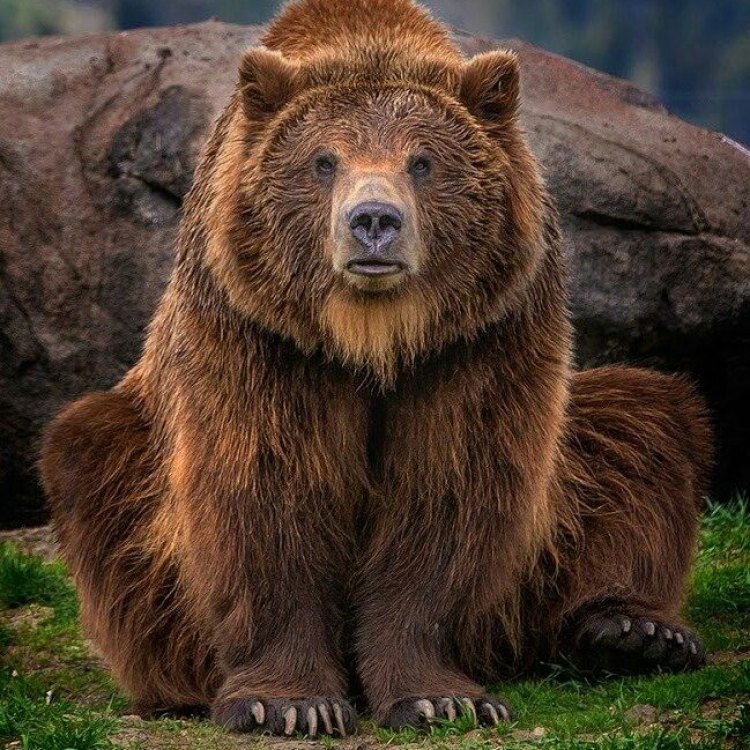
Grizzly Bear
- Adult Size: Up to 10 feet tall when standing on hind legs
- Average Lifespan: 20 to 25 years
- Reproduction: Sexual
- Reproductive Behavior: Mating occurs between May and July
- Sound or Call: Growls, roars, and bellows
- Migration Pattern: Some individuals may migrate short distances
- Social Groups: Solitary, except for mothers with cubs
- Behavior: Primarily diurnal, but can be active at night
- Threats: Habitat loss, illegal hunting, and climate change
- Conservation Status: Least Concern
- Impact on Ecosystem: Keystone species, helps regulate prey populations and vegetation
- Human Use: Hunting (regulated), tourism
- Distinctive Features: Humped shoulder and concave facial profile
- Interesting Facts: Grizzly bears can run up to 35 miles per hour and have an exceptional sense of smell
- Predator: No natural predators
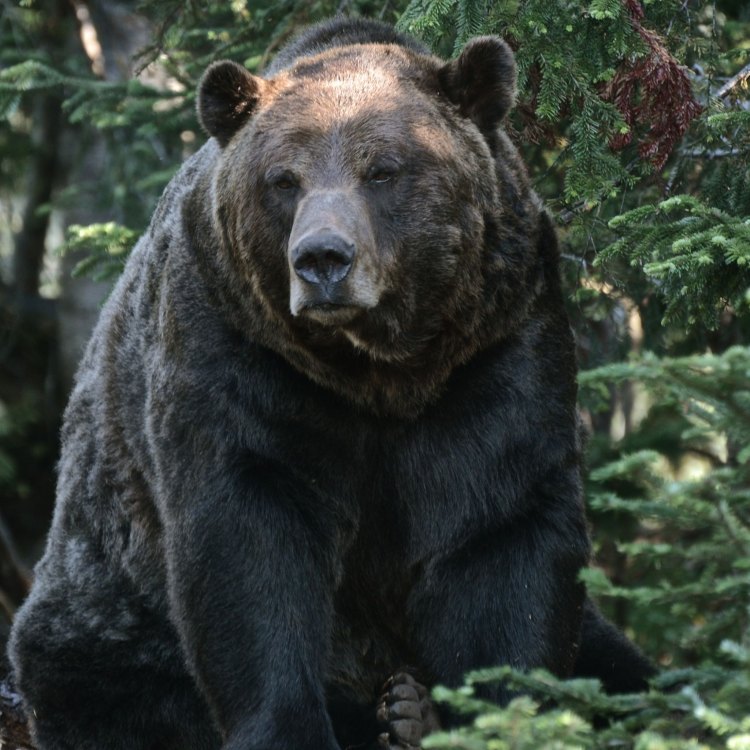
Ursus arctos horribilis
The Mighty Grizzly Bear: A Fascinating and Essential Keystone Species for Our Ecosystem
The grizzly bear, also known as the North American brown bear, is a powerful and majestic creature that captures the imagination of many who encounter it. With its massive size and distinctive features, it is no wonder that the grizzly bear has become a symbol of strength and resilience. But this magnificent creature is not just a symbol, it plays a crucial role in our ecosystem. In this article, we will explore the unique features and behaviors of the grizzly bear, its impact on our environment, and the conservation efforts being made to protect this iconic species PeaceOfAnimals.Com.Size and Lifespan
First and foremost, let’s talk about the physical characteristics of the grizzly bear. As one of the largest land predators in the world, a fully grown adult can reach heights of up to 10 feet when standing on its hind legs. This massive size is due to the grizzly bear’s humped shoulder and concave facial profile, which gives it a unique and intimidating appearance. On average, grizzly bears can weigh between 300 to 1,500 pounds, but some exceptional individuals have been recorded to weigh up to 1,800 pounds.
The grizzly bear’s size is not the only thing that is remarkable. They also have an impressive lifespan of 20 to 25 years in the wild. This is longer than most bears and is attributed to their formidable size and strength, which makes them less vulnerable to predators.
Reproduction and Behavior
Like most mammals, grizzly bears are sexual reproducers, meaning they require a mate to reproduce. Mating occurs between May and July, with females giving birth to typically 1-4 cubs after a gestation period of 180 to 250 days Golden Saint. These cubs are born blind, hairless, and weigh only about a pound, but they quickly grow and mature under the care and protection of their mother.
Grizzly bears are primarily solitary animals, except for mothers with cubs. They are known to be territorial and will defend their home range fiercely against other bears. Interestingly, grizzly bears are primarily diurnal, which means they are most active during the day. However, they can also be active at night, depending on the availability of food and other external factors.
Sound and Migration Patterns
The grizzly bear is not known for its vocal communication. In fact, it is not common to hear a grizzly bear make any sounds unless threatened or during mating season. When threatened, they will let out a loud growl or roar, which is often enough to scare off potential predators. During mating season, male grizzly bears will also bellow to attract females.
While grizzly bears are not known to migrate long distances, some individuals may migrate short distances to find food or in response to environmental changes. They are adaptable animals and can survive in a variety of habitats, including forests, grasslands, and tundra.
Threats and Conservation Status
Despite their impressive size and strength, the grizzly bear is facing numerous threats. Habitat loss, illegal hunting, and climate change are the main culprits behind their declining population. Habitat fragmentation due to human development and logging has reduced the amount of space available for grizzly bears to roam and find food. Illegal hunting, often for trophy hunting, also poses a significant threat to their survival.
Climate change is also affecting grizzly bears and their habitats. With rising global temperatures, food sources are becoming scarce, leading to increased competition and food shortages for grizzly bears. Moreover, climate change is altering the timing of hibernation and breeding, disrupting the natural cycle of these animals.
Currently, the grizzly bear is listed as Least Concern on the International Union for Conservation of Nature (IUCN) Red List. However, this does not mean that their population is not at risk. On the contrary, the grizzly bear population is declining, and conservation efforts are crucial in ensuring their survival.
Impact on Ecosystem
The grizzly bear is considered a keystone species, meaning it plays a disproportionately important role in its ecosystem. They help regulate prey populations, such as deer and elk, by keeping their numbers in check. This is essential for maintaining a healthy balance in the ecosystem. Grizzly bears also have a unique feeding behavior, which involves digging for roots and tubers. This behavior helps to aerate the soil, which promotes plant growth and diversity.
Another crucial role that grizzly bears play is in controlling vegetation. By foraging and dispersing seeds, they help to spread plants and create new food sources for other animals. Their grazing habits also help to maintain clearings in dense forests, creating space for new plant growth.
Human Use and Interesting Facts
For many years, grizzly bears have been hunted for their valuable fur and as a trophy animal. However, with the decline of their population, hunting is now strictly regulated in most parts of their range. Despite this, grizzly bears are still an important source of income for some communities through tourism. Many people travel to areas where grizzly bears reside, hoping to catch a glimpse of these magnificent creatures in their natural habitat.
In addition to their impressive size and strength, grizzly bears also have some unique capabilities. They can run up to 35 miles per hour, making them one of the fastest animals in North America. They also have an exceptional sense of smell, which is said to be 100 times stronger than a human’s sense of smell. This ability helps them to find food, avoid threats, and locate potential mates.
Unique Features and Predators
We cannot talk about grizzly bears without mentioning their most distinctive features – the humped shoulder and concave facial profile. These features are what distinguish them from other bear species and give them their signature appearance. The humped shoulder is made up of muscle and fat, which helps grizzly bears to dig and forage for food.
Interestingly, grizzly bears have no natural predators. With their massive size and powerful claws, they are not an easy target for other animals. However, young grizzly bears may fall prey to wolves, mountain lions, and other bears.
In conclusion, the grizzly bear is more than just a symbol of strength and power; it is a vital and valuable keystone species for our ecosystem. Their population may be declining, but through conservation efforts and responsible human behavior, we can ensure that these magnificent creatures continue to thrive in the wild. So next time you encounter a grizzly bear, remember to admire it from a safe distance and appreciate the important role it plays in our environment.
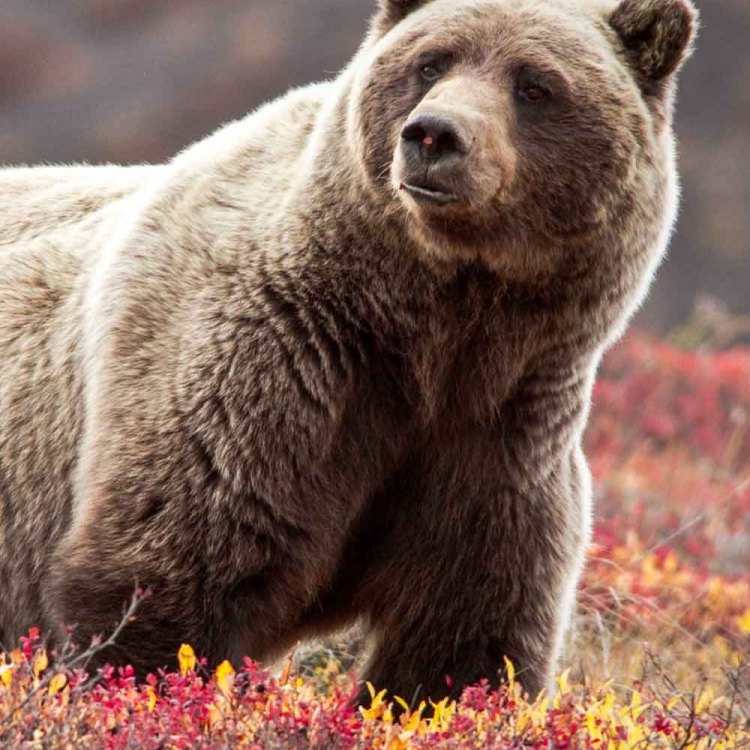
Grizzly Bears: The Fierce and Fascinating Giants of North America
Disclaimer: The content provided is for informational purposes only. We cannot guarantee the accuracy of the information on this page 100%. All information provided here may change without prior notice.

